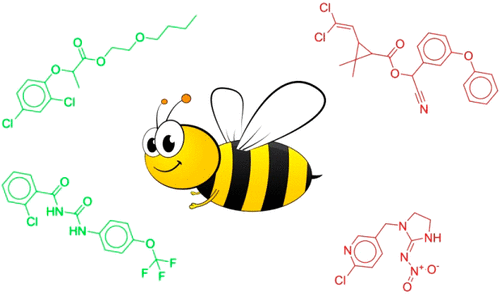当前位置:
X-MOL 学术
›
J. Chem. Inf. Model.
›
论文详情
Our official English website, www.x-mol.net, welcomes your feedback! (Note: you will need to create a separate account there.)
Insights into the Molecular Basis of the Acute Contact Toxicity of Diverse Organic Chemicals in the Honey Bee
Journal of Chemical Information and Modeling ( IF 5.6 ) Pub Date : 2017-12-11 00:00:00 , DOI: 10.1021/acs.jcim.7b00476 Xiao Li 1, 2 , Yuan Zhang 2 , Hongna Chen 3 , Huanhuan Li 2 , Yong Zhao 1, 2
Journal of Chemical Information and Modeling ( IF 5.6 ) Pub Date : 2017-12-11 00:00:00 , DOI: 10.1021/acs.jcim.7b00476 Xiao Li 1, 2 , Yuan Zhang 2 , Hongna Chen 3 , Huanhuan Li 2 , Yong Zhao 1, 2
Affiliation

|
Use of chemical pollutants, including pesticides and other industrial chemicals, has resulted in significant risks to the whole ecosystem. Therefore, ecological risk assessment of chemicals is vital and necessary. Since the honey bee (Apis mellifera) is probably among the most exposed species to the polluting chemicals, we focused on the in silico estimation of honey bee toxicity (HBT) of chemicals and the analysis of the relevance of chemical HBT and several key physical–chemical properties and structural characteristics. A total of 40 classification models were developed by combination of five machine learning methods along with seven kinds of fingerprints and a set of molecular descriptors. After 5-fold cross validation and external validation, several models showed good predictive power. The relevance of 12 key physical–chemical properties and chemical HBT was also investigated. Five properties, including AlogP, logD, molecular weight (MW), molecular surface area (MSA), and the number of rotatable bonds (nRTB), indicated positive correlation coefficients with HBT, while molecular solubility (logS) and the number of hydrogen bond donors (nHBD) indicated negative correlation coefficients. Finally, seven privileged substructures responsible for chemical HBT were identified from KRFP and SubFP fingerprints. The results of this study should provide critical information and useful tools for chemical HBT estimation in environmental risk assessment.
中文翻译:

蜜蜂对多种有机化学物质急性接触毒性的分子基础的认识
使用化学农药,包括农药和其他工业化学品,已对整个生态系统造成重大风险。因此,化学物质的生态风险评估至关重要且必要。由于蜜蜂(Apis mellifera)可能是受污染化学品暴露最严重的物种之一,因此我们将重点放在计算机上评估蜜蜂的化学毒性(HBT)以及分析化学HBT的相关性以及一些关键的理化特性和结构特征。通过五种机器学习方法,七种指纹和一组分子描述符的组合,总共开发了40个分类模型。经过5倍交叉验证和外部验证后,几个模型显示出良好的预测能力。还研究了12个关键物理化学性质与化学HBT的相关性。包括AlogP,logD,分子量(MW),分子表面积(MSA)和可旋转键数(nRTB)在内的五个特性表明与HBT的正相关系数,而分子溶解度(logS)和氢键数供体(nHBD)表示负相关系数。最后,从KRFP和SubFP指纹图中识别出七个负责化学HBT的特权子结构。这项研究的结果应为环境风险评估中的化学HBT估算提供关键信息和有用的工具。
更新日期:2017-12-11
中文翻译:

蜜蜂对多种有机化学物质急性接触毒性的分子基础的认识
使用化学农药,包括农药和其他工业化学品,已对整个生态系统造成重大风险。因此,化学物质的生态风险评估至关重要且必要。由于蜜蜂(Apis mellifera)可能是受污染化学品暴露最严重的物种之一,因此我们将重点放在计算机上评估蜜蜂的化学毒性(HBT)以及分析化学HBT的相关性以及一些关键的理化特性和结构特征。通过五种机器学习方法,七种指纹和一组分子描述符的组合,总共开发了40个分类模型。经过5倍交叉验证和外部验证后,几个模型显示出良好的预测能力。还研究了12个关键物理化学性质与化学HBT的相关性。包括AlogP,logD,分子量(MW),分子表面积(MSA)和可旋转键数(nRTB)在内的五个特性表明与HBT的正相关系数,而分子溶解度(logS)和氢键数供体(nHBD)表示负相关系数。最后,从KRFP和SubFP指纹图中识别出七个负责化学HBT的特权子结构。这项研究的结果应为环境风险评估中的化学HBT估算提供关键信息和有用的工具。



























 京公网安备 11010802027423号
京公网安备 11010802027423号